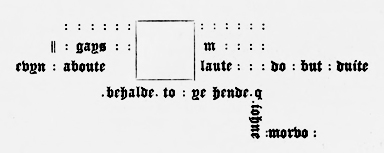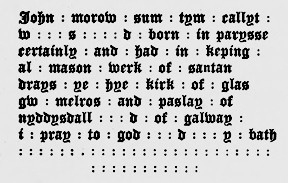Chapter XX: Remains
There has been considerable controversy as to the credibility of the tradition which assigns this tomb to Marjory Bruce.[22] It has been locally called “Queen Blearie's” tomb, the name “Blearie” which was given to Robert II. her son, having, it is supposed, in the lapse of years, been transferred to his mother. We see no reason to set aside the ancient tradition which assigns this tomb to Marjory Bruce. Though she was never a Queen, she was the daughter of one King, and the mother of another. “Time,” as it has been said, “produces many changes in early records, and it was a very natural one that the people should, in the course of ages, when speaking of the accident of King Robert's birth, designate his mother as Queen.” The figure on the tomb is obviously that of a female of rank connected with the family of Stewart. The Abbey was the place where Marjory would naturally be buried, and the Stewart is said to have caused a “fair monument” to be erected to his wife Robert Wyschard,[23] whose name is on the tomb, was Bishop of Glasgow, and was a captive in England with Marjory. He returned in her company to Scotland and was Bishop of the diocese at the time of her death. John Lithgow was Abbot during a great part of the reign of her son, and the monument was probably erected during his term of office, which accounts for his name being found upon it. We may add, also, that the features of the statue are said, on good authority, strikingly to resemble those of Robert the Bruce, the father of Marjory.[24]
The only name of any of the architects or builders of the Abbey that has come down to us is that of John Morow, or Murdo, a master mason, and Frenchman by descent. A Thomas Morwe was Abbot between 1420-23, and it is possible that they were related. We are indebted for our knowledge of the mason to two inscriptions on the wall of the south transept of Melrose Abbey.[25] Over a door in this transept there is a sunk panel, inclosing a shield, which displays two mason's compasses, partially opened, laid across one another, so as to form a figure somewhat like a saltire, and on each side, and in base, what has been described as a fleur de lis, forming probably a combined masonic and heraldic emblem. The compass is the badge of a master mason, and the three lilies may be those of the shield of France, his native country. On each side of this panel there are the remains of a black-letter inscription in relief. It is as follows:—

This is commonly taken to be—
Sa gayes the compass even about,
Sa trouth and laute do but doubt.
Behald to the hend, quoth John Morvo.
The sentiment of this inscription may be rendered thus :—As the compass goes round about without deviating from the circumference, so doubtless truth and loyalty never deviate. Look well to the end, or see to the work, quoth John Morvo. This Morow, we learn from another inscription, was the architect employed in the building, or, at least, in the maintenance of Paisley:—

[22] See Scot. Anti. Trans., Vol. II., part 2, pp. 456-461; also Appendix 3d Vol. of Maitland Club for 1831. The subject has also been discussed at great length in Notes and Queries and Hamilton's Renfrewshire, Appendix III.
[23] Sir James Balfour's Annals, Vol. I., p. 96.
[24] I have been assured of this on the authority of a very eminent numismatist.
[25] Trans. of Society of Antiquaries—Notes on Melrose Abbey, by John Alexander Smith, M.D. F.S.A. Scot., from which I have taken the description above.